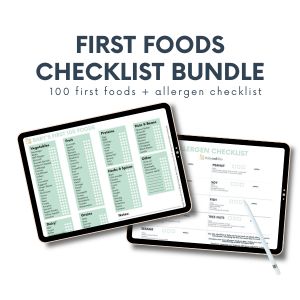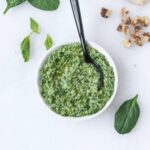Fresh tomatoes can be a choking hazard for babies, so it's important to pay close attention to how you serve them to your little one. Use these tips to safely cut and serve tomatoes for baby led weaning.

While technically considered a fruit, most put tomatoes in the vegetable category. Fresh tomatoes are delicious in the summer months here in the US and are nutrient-rich for babies, especially if you can get them from your local farmer's market or right from your own backyard! But because tomatoes are a slippery texture and can come in small, round shapes, they can be a choking hazard. Here is everything you need to know about how to safely serve tomatoes to your baby using a baby led weaning approach.
Jump to:
Can Babies Eat Tomatoes?
Yes! Babies can eat tomatoes as soon as they are developmentally ready for solids around 6 months of age. Tomatoes have multiple textures - slippery skin, juicy pulp, seeds - so they can be challenging for new eaters to eat. It may be best to serve tomato when baby is alert and eager to eat, not tired or cranky.
Cherry and grape tomatoes are a common choking hazard because they are small, round, and slippery, so I recommend waiting until baby is closer to 9 months before offering them, and they must be quartered to eliminate the round shape.
Baby Health Benefits
Tomatoes are high in vitamin C, which helps baby's body absorb iron, and potassium, which is good for fluid balance and blood pressure. They are a great source of phytonutrients and antioxidants, such as lycopene, beta carotene, lutein and zeaxanthin, which help fight inflammation, promote good eye and skin health, and aid the immune system. Tomatoes also contain smaller amounts of important nutrients such as folate, choline, and calcium.1
Cooking tomatoes changes the amounts and bioavailability of certain nutrients. Cooked tomatoes are higher in lycopene, an antioxidant that could protect against cancer, heart disease, and even sunburn.2 Cooked tomatoes are higher in lutein and zeaxanthin, antioxidants that protect eye and skin health. Cooking tomatoes also reduces the amount of vitamin C.3
Baby Tomato Allergies
Tomato allergies are rare, but they can happen. They are also part of the nightshade family of vegetables, which some people are sensitive to. People with Oral Allergy Syndrome may also react to tomatoes, especially those with allergies to grass, ragweed or latex. Oral Allergy Syndrome may cause itching or discomfort around the mouth. It can be reduced by cooking tomatoes.
If your baby experiences a rash on the hands or mouth (or diaper rash) when eating tomatoes, it may be due to the fact that tomatoes are very acidic. This kind of rash will disappear within a few minutes after washing up and is harmless. If any discomfort happens, reduce the amount of tomato that is offered at one time.
How To Cut Tomatoes for Baby Led Weaning

Tomatoes must be cut before serving to babies to eliminate the round shape, which can be a choking hazard. Here are the best ways to cut fresh tomatoes for baby led weaning by age.
1. Large wedge (6+ months)
Cut a large, juicy tomato into quarters and offer a quarter to baby. Younger babies will be more easily able to pick up a large wedge and suck the juices and munch on the pulp. If the wedge gets to be frustrating to baby, you can take it away and offer another. You can also serve large wedges that have been cooked (such as roasted or on the grill). If this is the case, the skin should be easy to peel off and discard so that it doesn't get in baby's way.
2. Very thin slice, halved (6+ months)
At this stage, you can also offer very thin slice (think paper thin) that has been cut in half into a half-moon shape. Baby should be able to scoop it up and munch on the portion sticking out from his fist.
3. Quartered grape tomatoes (9+ months)
Once baby develops a pincer grasp and has matured a little bit in eating skills, you can offer grape tomatoes that have been quartered down the long end. I prefer the oblong grape tomatoes over perfectly round cherry tomatoes. Supervise closely, and if any skin gets stuck in baby's mouth, calmly coach him to spit it out.

Other Ways To Serve Tomatoes With Baby Led Weaning
Fresh tomatoes may make you nervous as a parent (understandable!), they may cause a rash due to the acidity, or they may simply not be in season. If that's the case, you can always serve cooked or canned tomato products! A few examples include:
- Crushed tomatoes or tomato puree on a pre-loaded soft spoon or spread on toast fingers
- Spaghetti sauce sauce on your favorite BLW friendly pasta (try my Super Veggie Pasta Sauce!)
- Canned tomatoes in mixed dishes, such as soups or casseroles (be sure they are small enough to not pose a choking risk)

Track your baby's journey through starting solids! Get my 100 First Foods Checklist and Allergen Checklist Bundle today!
FAQ
Yes, especially cherry and grape tomatoes. See guidelines above for safely serving tomatoes to babies. Always supervise baby closely any time he is eating!
No, though tomatoes can cause a reaction for those with nightshade sensitivities or Oral Allergy Syndrome. As with any new food, start slow with just a little bit and observe for a reaction.
Tomatoes and other acidic foods can cause redness or a mild skin rash around the mouth and hands where there has been skin contact, or a diaper rash. This harmless rash should disappear within a few minutes after washing up.
No, you do not need to peel the skin off of fresh tomatoes. However, the skin can cause gagging and frustration for baby if some comes away from the pulp and gets caught up in his mouth. If this is the case, calmly coach his to spit it out and remove it from the tray. If you are serving cooked tomatoes, the skin should separate easily and can be removed.
Ketchup (I believe called tomato sauce in places other than the US) is high in sugar or corn syrup and should not be given to babies before 12 months (and preferably before 24 months). I also prefer not to get kids in the habit of needing a sugary sauce to dip everything in. Though (appropriate) sauces can be great, interesting new flavors for baby to try, avoid the ketchup trap as long as you can!
This will vary depending on your child's eating skills. Once your baby has developed mature eating skills (takes small bites, can easily move food around the mouth with his tongue, chews well before swallowing, doesn't overstuff the mouth), you can progress to halved cherry or grape tomatoes, usually around 24 months. Once he has mastered halved tomatoes, you can offer whole ones. Choose larger cherry or grape tomatoes that baby is more likely to need to bite in half, and demonstrate biting into one for him. Then offer a whole one and observe to make sure he doesn't stuff the whole thing in his mouth.
Resources:

















Leave a Reply